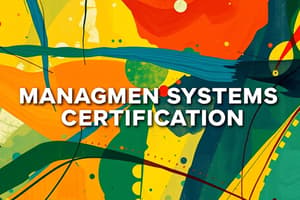Podcast
Questions and Answers
What is the primary focus of administration in an organization?
What is the primary focus of administration in an organization?
- Formulating policies and regulations (correct)
- Managing daily operations
- Evaluating employee performance
- Implementing policies
Which of the following statements best describes management?
Which of the following statements best describes management?
- It is the legislative body of an organization.
- It focuses solely on policy formulation.
- It is solely the role of the organization’s owners.
- It involves determining objectives and utilizing resources to achieve them. (correct)
What distinguishes administration from management?
What distinguishes administration from management?
- Administration is only concerned with employee relations.
- Administration focuses on policy enforcement, while management focuses on implementation. (correct)
- Management is more strategic than administration.
- Administration deals only with financial resources.
In the context of organizational hierarchy, administration is regarded as:
In the context of organizational hierarchy, administration is regarded as:
Who is primarily responsible for legislation and determination in an organization?
Who is primarily responsible for legislation and determination in an organization?
What must planners regularly do to ensure their plans remain effective?
What must planners regularly do to ensure their plans remain effective?
What is the main focus of strategic planning?
What is the main focus of strategic planning?
How does operational planning differ from strategic planning?
How does operational planning differ from strategic planning?
What characterizes a standing plan?
What characterizes a standing plan?
Which type of planning is primarily focused on immediate issues and concerns of a team?
Which type of planning is primarily focused on immediate issues and concerns of a team?
What is a key benefit of planning in an organization?
What is a key benefit of planning in an organization?
What type of plan is usually created for a specific, one-time purpose?
What type of plan is usually created for a specific, one-time purpose?
What role do middle-level managers typically play in tactical planning?
What role do middle-level managers typically play in tactical planning?
What is the primary goal of establishing clear-cut relationships between roles in an organization?
What is the primary goal of establishing clear-cut relationships between roles in an organization?
Which principle of quality assurance emphasizes eliminating mistakes immediately?
Which principle of quality assurance emphasizes eliminating mistakes immediately?
What does Total Quality Management (TQM) emphasize in a company?
What does Total Quality Management (TQM) emphasize in a company?
What method is used to test product limits through extreme conditions until failure occurs?
What method is used to test product limits through extreme conditions until failure occurs?
Which approach focuses on setting quality standards and evaluating quality management issues at the organizational level?
Which approach focuses on setting quality standards and evaluating quality management issues at the organizational level?
How does quality assurance differ fundamentally from quality control?
How does quality assurance differ fundamentally from quality control?
What is the purpose of using statistical tools in Statistical Process Control (SPC)?
What is the purpose of using statistical tools in Statistical Process Control (SPC)?
Which of the following contributes to a sense of security among employees?
Which of the following contributes to a sense of security among employees?
What is a primary benefit of planning in an organization?
What is a primary benefit of planning in an organization?
How does planning assist in avoiding wasted activities?
How does planning assist in avoiding wasted activities?
What should be established to deal with resistance to change among workers?
What should be established to deal with resistance to change among workers?
What does organizing in a workplace involve?
What does organizing in a workplace involve?
What is a key aspect of planning for change?
What is a key aspect of planning for change?
Why is specialization important in organizing?
Why is specialization important in organizing?
What role does job definition play in organizing?
What role does job definition play in organizing?
How can authority clarification improve organizational efficiency?
How can authority clarification improve organizational efficiency?
What is a key benefit of implementing a quality assurance program?
What is a key benefit of implementing a quality assurance program?
Which characteristic defines a true audit?
Which characteristic defines a true audit?
What is the primary focus of internal audits?
What is the primary focus of internal audits?
What is one of the main purposes of monitoring in project management?
What is one of the main purposes of monitoring in project management?
How does auditing typically improve corporate accountability?
How does auditing typically improve corporate accountability?
Which of the following is not a benefit of effective monitoring and evaluation?
Which of the following is not a benefit of effective monitoring and evaluation?
What is a key characteristic of external audits?
What is a key characteristic of external audits?
What is the first step in the problem-solving process?
What is the first step in the problem-solving process?
What is the primary focus of feedback control?
What is the primary focus of feedback control?
Which control type focuses on foreseeing and preventing potential problems?
Which control type focuses on foreseeing and preventing potential problems?
What is a characteristic of the commitment-based approach to control?
What is a characteristic of the commitment-based approach to control?
Which of the following is NOT part of the traditional approach to management control?
Which of the following is NOT part of the traditional approach to management control?
What should controls reflect according to the checklist for effective control?
What should controls reflect according to the checklist for effective control?
Which area does NOT fall under the scope of control?
Which area does NOT fall under the scope of control?
What is the first step in the processes of controlling in management?
What is the first step in the processes of controlling in management?
Which type of control mechanism detects issues immediately to prevent losses?
Which type of control mechanism detects issues immediately to prevent losses?
Flashcards
Management
Management
The process of utilizing an organization's resources to manage people and their work towards a common goal.
Administration
Administration
A group of people collectively managing the entire organization and responsible for formulating policies.
Management focus
Management focus
Management focuses on executing policies and achieving goals.
Administration focus
Administration focus
Signup and view all the flashcards
Management vs. Administration
Management vs. Administration
Signup and view all the flashcards
Feedback Control
Feedback Control
Signup and view all the flashcards
Concurrent Control
Concurrent Control
Signup and view all the flashcards
Predictive Control
Predictive Control
Signup and view all the flashcards
Steering Control
Steering Control
Signup and view all the flashcards
Yes/No Control
Yes/No Control
Signup and view all the flashcards
Budgetary Control
Budgetary Control
Signup and view all the flashcards
Strategic control
Strategic control
Signup and view all the flashcards
Controls should reflect the task
Controls should reflect the task
Signup and view all the flashcards
Decision-making in planning
Decision-making in planning
Signup and view all the flashcards
Evaluation in planning
Evaluation in planning
Signup and view all the flashcards
Strategic planning
Strategic planning
Signup and view all the flashcards
Tactical planning
Tactical planning
Signup and view all the flashcards
Operational planning
Operational planning
Signup and view all the flashcards
Standing plan
Standing plan
Signup and view all the flashcards
Single-use plan
Single-use plan
Signup and view all the flashcards
Day-by-day planning
Day-by-day planning
Signup and view all the flashcards
Planning provides direction
Planning provides direction
Signup and view all the flashcards
Planning reduces waste
Planning reduces waste
Signup and view all the flashcards
Planning sets standards
Planning sets standards
Signup and view all the flashcards
Planning for change
Planning for change
Signup and view all the flashcards
Worker response to change
Worker response to change
Signup and view all the flashcards
Dealing with resistance
Dealing with resistance
Signup and view all the flashcards
Organizing for efficiency
Organizing for efficiency
Signup and view all the flashcards
Organizing steps
Organizing steps
Signup and view all the flashcards
Coordination
Coordination
Signup and view all the flashcards
Effective Administration
Effective Administration
Signup and view all the flashcards
Growth & Diversification
Growth & Diversification
Signup and view all the flashcards
Sense of Security
Sense of Security
Signup and view all the flashcards
Quality Assurance (QA)
Quality Assurance (QA)
Signup and view all the flashcards
Total Quality Management (TQM)
Total Quality Management (TQM)
Signup and view all the flashcards
Failure Testing
Failure Testing
Signup and view all the flashcards
Process & Product QA (PPQA)
Process & Product QA (PPQA)
Signup and view all the flashcards
What is Auditing?
What is Auditing?
Signup and view all the flashcards
What is an Internal Audit?
What is an Internal Audit?
Signup and view all the flashcards
What is an External Audit?
What is an External Audit?
Signup and view all the flashcards
What is a Government Audit?
What is a Government Audit?
Signup and view all the flashcards
What is Monitoring?
What is Monitoring?
Signup and view all the flashcards
What is Evaluation?
What is Evaluation?
Signup and view all the flashcards
What is Evaluation in Planning?
What is Evaluation in Planning?
Signup and view all the flashcards
What is Problem-Solving?
What is Problem-Solving?
Signup and view all the flashcards
Study Notes
Management and Administration in Nursing
- Management is a process used to achieve objectives with human and other resources.
- Management encompasses all organizational activities related to goal setting, achievement, performance evaluation, and developing a working philosophy for survival in a social system.
- Management utilizes organizational resources to manage people and their work towards a common goal.
- Management professionals use their skills to manage the entire organizational system.
- Administration is the systematic process of governing a business, an educational institution (like a school), a government office, or a non-profit organization.
- Administration operates at the highest level of management in an organization's hierarchy.
- Administration establishes objectives, creates policies and procedures, and enforces regulations.
Key Differences Between Management and Administration
| Feature | Management | Administration |
|---|---|---|
| Approach | Systematic approach to managing people and resources | Collective management of the entire organization |
| Focus | Policy implementation | Policy formulation |
| Role | Executive and governing functions | Responsibility for legislation and determination |
| Personnel | Employees | Owners of the organization |
| Decision Making | Decisions under the limits of the administration. | Takes all important decisions of the organization |
| Focus of responsibilities | Who does the work | What and when work is performed |
| Organizational type | Found in profit-making organizations | Found in government and military offices, clubs, and hospitals |
Management
- Key activities include planning, organizing, leading, motivating, controlling, coordinating, and decision-making.
- Management utilizes the 5Ms of an organization (Men, Materials, Machines, Methods, and Money) to achieve specific outcomes while guaranteeing all necessary steps are taken.
Features of Management
- Universal: Applicable across all institutions (social, religious, commercial, educational, political).
- Integrative: Harmonizes individual goals with organizational goals.
- Action-oriented: Organizes and employs resources to accomplish predefined objectives.
- People-centered: Occurs through people.
- Intangible force: Managerial competence as a social skill, evidenced in quality and level.
- Dynamic: Ongoing and subject to change based on business circumstances.
- Science and Art: Based on underlying knowledge and essential skills unique to individuals.
Basic Management Actions
- Identify necessary actions or tasks.
- Organize resources.
- Ensure efficient and effective task completion.
- Plan for future needs.
- Address arising problems.
Management Skills
- Technical Skills:
- Ability to work with resources within a specific expertise.
- Possessing technical knowledge and proficiency to achieve specialized tasks effectively.
- Human Skills:
- Ability to interact efficiently with people.
- Leading, motivating, managing conflicts, and working cooperatively with others.
- Conceptual Skills:
- Understanding organization as a whole.
- Recognizing interdependencies among organizational functions.
- Formulating ideas, understanding relationships, and visualizing the relationships between businesses, industry, community, and national political, social, and economic forces.
- Diagnostic Skills
- Ability to investigate problems and choose solutions. (Requires technical, human, and conceptual skills).
- Political Skills
- Ability to acquire authority for achieving objectives.
- Establishing connections and impressing the right people.
Managerial Roles
- Interpersonal Roles:
- Figurehead: Symbolic head of the organization.
- Leader: Directing, staffing, motivating, and guiding employees.
- Liaison: Maintains network of outside contacts, gaining favors, and maintaining external relationships.
- Informational Roles:
- Monitor: Receives and communicates important information.
- Disseminator: Transmitting information from internal sources to other parts of the organization.
- Spokesperson: Provides information to internal/external groups.
- Decisional Roles:
- Entrepreneur: Initiates change within the organization.
- Disturbance Handler: Manages threats from politics, competition, unions, conflicts, etc.
- Resource Allocator: Decides on the allocation of resources (money, equipment, personnel).
- Negotiator: Negotiates internally and externally.
Functions/Principles of Management - Controlling
- Controlling: Giving instructions, ensuring adherence to instructions.
- Types of Management Control:
- Feedback Control: Gather information about completed tasks, evaluate, and use it for future improvement.
- Concurrent Control: Real-time control mechanism to detect and address issues immediately, preventing losses.
- Other Control Types:
- Predictive Control: Prevents problems by anticipating them.
- Steering Control: Directs the process onto the right path.
- Yes/No Control: Decides whether an activity should proceed.
- Budgetary Control: Manages organizational resources and budgets.
- Strategic Control: Ensures alignment with goals through strategic planning.
Check List for Effective Control
- Controls reflect the nature and needs of the activity.
- Reports deviations promptly.
- Takes a forward-looking/future outlook.
- Identifies exceptions at strategic points.
- Maintains objectivity.
- Is flexible, reflects organizational structure, and is economical and understandable.
- Indicates corrective action.
Two Basic Control Approaches
- Traditional Approach:
- Sets standards, targets, or goals.
- Measures actual performance against standards.
- Takes corrective action.
- Commitment-Based Approach:
- Gains employee commitment to quality.
- Invests in the right people.
- Fosters self-control.
- Promotes a sense of community and shared fate.
- Guarantees organizational justice.
- Implements profit-sharing.
- Encourages self-actualization.
Scope of Area of Control
- Policies and procedures
- Organization
- Staff
- Methods
- Expenditure/income
- Research and development
Processes of Controlling in Management
- Formation of standards
- Measurement of actual performance
- Comparison of actual and standard performance
- Corrective actions
Functions/Principles of Management - Directing
- Directing: Guiding, inspiring, overseeing, and instructing people towards organizational goals.
- Characteristics of Directing:
- Pervasive: Necessary at all organizational levels.
- Continuous: Ongoing throughout the organization's lifespan.
- Human Factor: Deals with the unpredictable nature of human behavior.
- Creative Activity: Transforms plans into performance.
- Executive Function: Carried out by all managers and executives.
Importance of Directing Function
- Initiates actions, providing direction for subordinates.
- Integrates efforts from all departments.
- Adapts to changes within and outside the organization.
- Allows for efficient use of resources.
Functions/Principles of Management - Planning
- Planning: Setting objectives and creating a plan to achieve them.
- Steps in Planning:
- Environmental scanning: Considering economic conditions, competitors, customers, and forecasting future conditions.
- Establishing objectives: Defining what needs to be achieved, when, and how.
- Identifying alternative courses of action: Assessing various strategies and approaches.
- Decision-making: Selecting the best course of action and formulating necessary steps for it implementation.
- Evaluation: Regularly assessing the effectiveness of plans and making adjustments.
Types of Planning
- Strategic Planning: Analyze competitive landscape, identify strengths, weaknesses, opportunities and threats to position in the market.
- Tactical Planning: Develop specific means for implementing the strategic plan at the middle-management level.
- Operational Planning: Outlines short-term steps to support strategic and tactical plans, within a year's time-frame.
- Standing Plans: Repetitive routines or formulas to deal with recurring situations.
- Single-use Plans: Unique plans for one-time events or purposes (e.g., major changes, budget adjustments).
- Day-by-Day Planning: Priorities set by first-line supervisors (adjustments to long-term plans as needed).
Importance of Planning
- Aids decision-making
- Decreases risk
- Encourages innovative ideas
- Provides directions and framework for necessary actions
- Decreases overlapping/wasteful activities
- Sets standards for controlling performance
- Plans for change, carefully and thoroughly.
- Accounts for the impact of change and risk.
Planning for Change
- Change requires careful and thorough planning.
- Similarities to other types of planning, with unique considerations concerning forecasting, risk, and change impact.
- Understanding worker responses and dealing with resistance (open communication, emphasis on advantages, involvement).
- Includes worker input to enhance organizational acceptance and integration.
Organizing
- Organizing: Distributing employees and allocating resources to promote productivity and efficiency.
- Steps in Organizing:
- Identifying activities, prioritizing what needs to be done.
- Departmentally organizing activities.
- Classifying authority (establishing a hierarchical ranking of positions and powers).
- Coordinating between authority and responsibilities.
Importance of Organizing
- Specialization within different areas of concern.
- Well-defined jobs and roles for clear responsibilities.
- Clarity of authority to prevent misuse of power, improving efficiency.
- Coordination and relationships to ensure effective collaboration.
- Effective administration, growth, and sense of security.
Quality Assurance
- Process for establishing standards, guidelines, and procedures to prevent quality issues and maintain product/service integrity throughout development.
- Principles: "fit for purpose" and "right first time."
- Methods like Total Quality Management (TQM), Failure Testing, Process and Product QA, and Statistical Process Control (SPC).
Auditing
- Auditing: A systematic and disciplined approach to evaluating and improving processes and controls, performed by independent and certified individuals.
- Characteristics of Auditing:
- Completed by independent professionals.
- Formal, systematic, and structured.
- Involves planning, sampling, testing, and validation.
- Includes formal communication with recommendations and corrective action measures.
- Accountability typically to the Chief Audit Executive and Audit Committee.
Types of Audits
- Internal Audits: Performed by employees for use by management and internal stakeholders.
- External Audits: Performed by external organizations, giving an unbiased opinion.
- Government Audits: Ensures accurate financial statements for tax purposes.
Monitoring and Evaluation
Effective monitoring and evaluation are necessary for successful projects. Involves collecting and analyzing data to assess goal achievement.
Problem-Solving
- Problem-solving involves defining, identifying the cause, prioritizing, and implementing solutions.
- Defining the problem, identifying underlying causes, differentiating fact from opinion, and clearly defining the problem.
- Generating short- and long-term alternative solutions consistent with organizational goals.
- Evaluating and selecting the best alternative, considering proven and possible outcomes.
- Implementing the solution and following up with feedback to all affected parties.
Studying That Suits You
Use AI to generate personalized quizzes and flashcards to suit your learning preferences.




